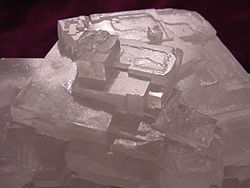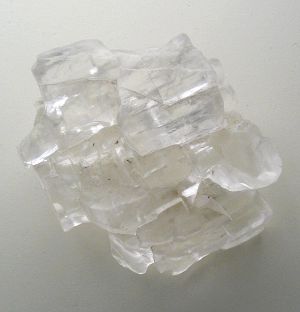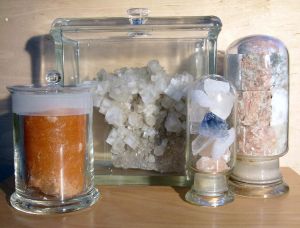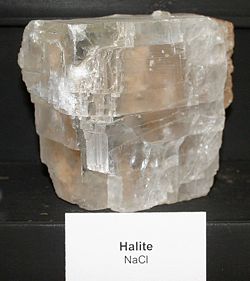Halite
| Halite | |
|---|---|
 |
|
| General | |
| Category | Halide mineral |
| Chemical formula | Sodium chloride NaCl |
| Identification | |
| Color | clear or white; also blue, purple, pink, yellow, and gray |
| Crystal habit | predominantly cubes and in massive sedimentary beds, but also granular, fibrous and compact |
| Crystal system | isometric 4/m bar 3 2/m |
| Cleavage | perfect in three directions |
| Mohs Scale hardness | 2 - 2.5 |
| Luster | vitreous |
| Refractive index | 1.544 |
| Streak | white |
| Specific gravity | 2.1 |
| Solubility | in water |
| Other Characteristics | salty flavor |
Halite is the mineral form of sodium chloride, NaCl, commonly known as rock salt. Halite forms isometric crystals. The mineral is typically colourless to white, but may also be light blue, dark blue, and pink. It commonly occurs with other evaporite deposit minerals such as several of the sulfates, halides and borates.
Halite occurs in vast beds of sedimentary evaporite minerals that result from the drying up of enclosed lakes, playas, and seas. Salt beds may be up to 350 m thick and underlie broad areas. In the United States and Canada extensive underground beds extend from the Appalachian basin of western New York through parts of Ontario and under much of the Michigan basin. Other deposits are in Ohio, Kansas, New Mexico, Nova Scotia, and Saskatchewan.
Salt domes are vertical diapirs or pipe-like masses of salt that have been essentially "squeezed up" from underlying salt beds by mobilization due to the weight of overlying rock. Salt domes contain anhydrite, gypsum, and native sulfur, in addition to halite and sylvite. They are common along the Gulf coasts of Texas and Louisiana and are often associated with petroleum deposits. Germany, Spain, the Netherlands, Romania, and Iran also have salt domes. Salt glaciers exist in arid Iran where the salt has broken through the surface at high elevation and flows downhill. In all of these cases, halite is said to be behaving in the manner of a rheid.
Unusual, purple, fibrous vein filling halite is found in France and a few other localities. Halite crystals termed hopper crystals appear to be "skeletons" of the typical cubes, with the edges present and stairstep depressions on, or rather in, each crystal face. In a rapidly crystallizing environment the edges of the cubes simply grow faster than the centers. Halite crystals form very quickly in some rapidly evaporating lakes resulting in modern artefacts with a coating or encrustation of halite crystals. Halite flowers are rare stalactites of curling fibers of halite that are found in certain arid caves of Australia's Nullarbor Plain. Halite stalactites and encrustations are also reported in the Quincy native copper mine of Hancock, Michigan.
See also
- Edible salt
- Sodium chloride
- History of salt
- Winsford – for rock salt mine in England
ReferencesISBN links support NWE through referral fees
- Hurlbut, Cornelius S.; Klein, Cornelis, 1985, Manual of Mineralogy, 20th ed., John Wiley and Sons, New York ISBN 0-471-80580-7
- Mineral Galleries
- WebMineral
- Minerals.net
- Desert USA
- Halite stalactites
Template:Inorganic-compound-stub
ca:Halita cs:Halit de:Halit et:Haliit es:Halita fr:Halite ko:암염 he:הליט it:Halite lt:Akmens druska no:Halitt nl:Haliet ja:岩塩 pl:Sól kamienna pt:Halita ro:Sare gemă ru:Галит sk:Halit fi:Vuorisuola uk:Галіт zh:矿盐



